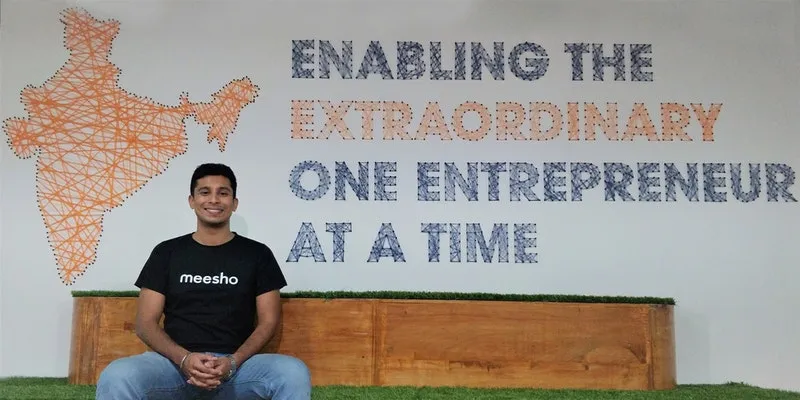[YS Exclusive] Vidit Aatrey on why Meesho is doubling down on grocery for Tier II markets leveraging local communities
In an exclusive conversation with YourStory, Vidit Aatrey, Co-founder and CEO, Meesho, talks about Farmiso (Meesho Grocery), making online grocery shopping affordable for Tier II+ customers, and banking on the community model.
Social commerce platform raised $570 million — its largest-ever round — at a valuation of $4.9 billion, more than twice what it was less than six months ago. The round was led by Fidelity Management and Research Company and B Capital Group.
The startup plans to use this funding to grow its technology and product talent by 2.5x, increase its roster to 50+ million products, and become the platform of choice for customers, entrepreneurs, and sellers from across India.
It is also going to expand its grocery and FMCG offerings with Farmiso (Meesho Grocery), its community grocery buying business, to 200+ cities.
Meesho aims to make online grocery shopping affordable for first-time users across India’s Tier II markets, enabling them to shop from a wide selection at ticket sizes as low as $1-$2.
In an exclusive conversation with YourStory, Vidit Aartrey, Co-founder and CEO, Meesho, discusses this expansion, the effect of the existing competition, and more

Vidit Aatrey, Founder and CEO, Meesho
Edited excerpts below:
YourStory (YS): Why expand grocery and how do you think Meesho can win this market?
Vidit Aatrey (VA): Grocery as a category is a large percentage of the wallet spend of our customer base. Our core audience is from the mid- to low-income segments across the country. We think we will win because, so far, companies have been focused on building a grocery model only for the Tier I cities.
The convenient grocery and the whole basket model have worked only for metro cities. In small towns, you won’t find people buying groceries like that.
We have taken a very different approach, building a low-cost grocery online model so that people in Tier II cities can afford to buy their groceries online.
YS: But there are so many players in the market. What is Meesho’s USP?
VA: Close to 60 percent of all retail is grocery; it is a large market. One of the main reasons behind our aim to crack grocery, even though it is the hardest market, is because it is extremely important strategically.
If you look at any other player, their business models are different from ours. We see customers differently.
We are looking at it as “Community 2.0”, where we leverage our local communities in both aggregating volumes and do the last-mile delivery for us. Since all this happens at a single point, the cost of logistics drops significantly. Our focus is on ‘fresh’, as it is the highest frequency category.
For example, we are in 20-30 towns in Karnataka beyond Bengaluru. Consumers buy from us in small amounts, multiple times every week, instead of a monthly basket.
This is the natural buying behaviour among the low-income segment; they get daily or weekly wages. They buy small amounts — multiple times. It is one of the reasons why the one-rupee shampoo sachet works so well. We are focused on small-ticket items.
YS: How do you think the community model helps?
VA: We have always leveraged the power of community since we started the business. Even our women entrepreneurs will create their own WhatsApp groups within the community and start promoting products. It is the same model.
We have also asked our community leaders to do the last-mile fulfilment for us. Most of these are kirana shops or local businesses. They sign up on Meesho and their job is to create awareness about our grocery model in that area.
Once an order is fulfilled it is delivered to their drop point, and then they ask customers to either pick it up from their shop, or they do home deliveries on their own.
YS: Grocery is notoriously known for thin margins. How do you intend to crack that? What numbers do you see from your pilots?
VA: We have innovated on the supply chain. We don’t do warehousing, or the conventional grocery supply chain. The biggest cost in grocery is almost always the last fulfilment cost that people have to bear.
Instead of using logistics companies, we use community leaders. For them, it is an additional income. The cost of fulfilment drops. While we can’t share numbers, since the model is different, we are able to fulfil the $1-$2 basket size with ease.
We have learnt that this model is what consumers prefer; they are able to use their offline model of going to the kirana store multiple times now — but through our app. We have seen a strong customer pull.
We have also seen strong unit economic sense, and community leaders too want to do this, and even local farmers are willing to sell on our marketplace. We see high adoption and we want to grow aggressively.
YS: What are your overall plans for the future?
VA: Apart from grocery, we are aggressive in our R&D investments of tech, product, and design. We plan to scale our team by 2-3x in 18 months.
We're doing this because we can build lots of useful tools for the entire ecosystem. In terms of investment round, we aim to penetrate a lot more into our consumer and seller bases.
Edited by Saheli Sen Gupta


![[YS Exclusive] Vidit Aatrey on why Meesho is doubling down on grocery for Tier II markets leveraging local communities](https://images.yourstory.com/cs/2/a9efa9c02dd911e9adc52d913c55075e/meesho-1632990286764.png?mode=crop&crop=faces&ar=2%3A1&format=auto&w=1920&q=75)
![[Funding alert] Meesho raises $570M from Fidelity and B Capital at $4.9B valuation](https://images.yourstory.com/cs/2/11718bd02d6d11e9aa979329348d4c3e/meesho-1632985657596.png?fm=png&auto=format&h=100&w=100&crop=entropy&fit=crop)






